|
| Floating Utah's Green River |
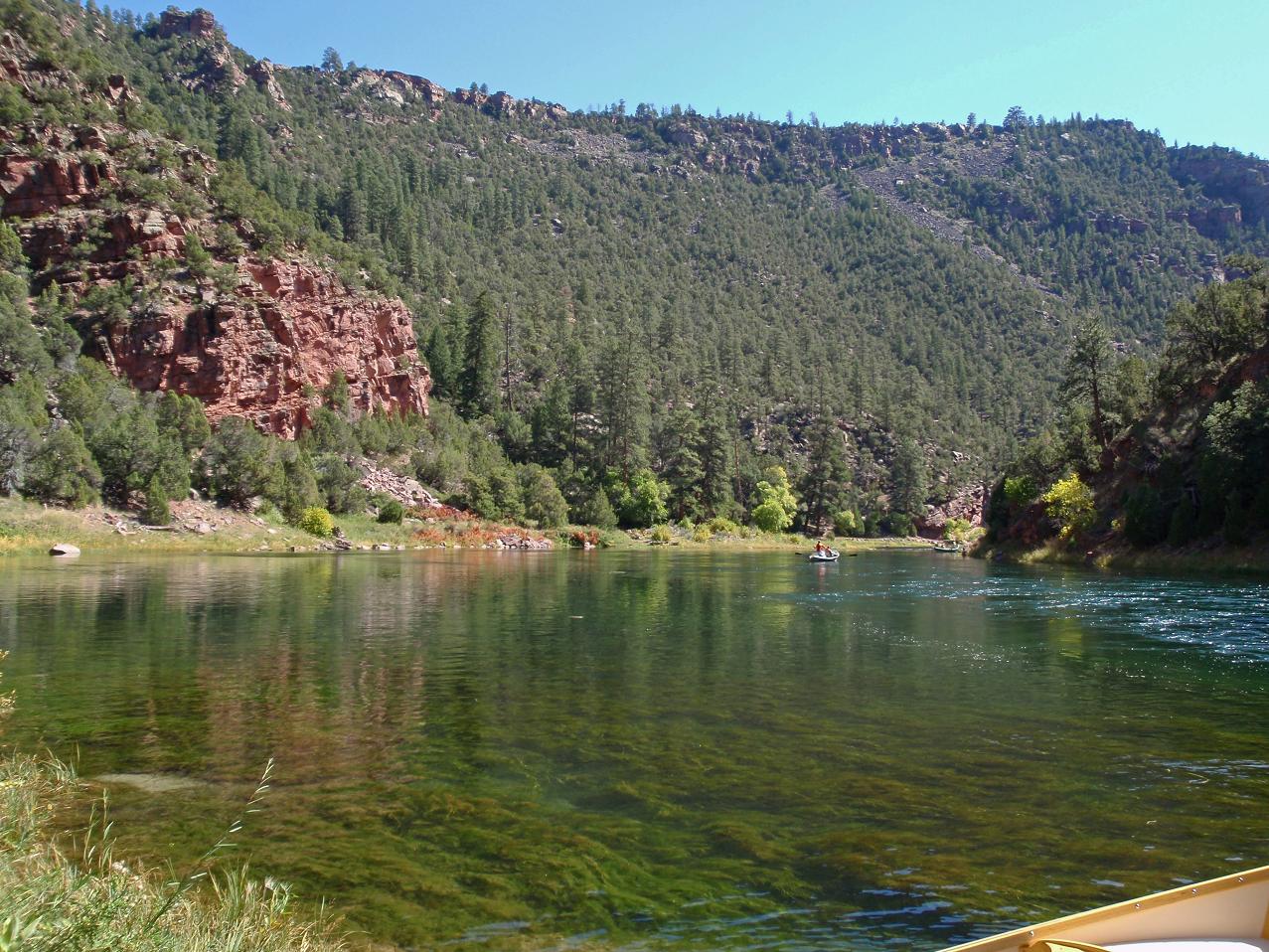
|
Utah!!
After 16 years living in Colorado, I have moved to Salt Lake City.
Although I was initially worried that I would not have as many fishing opportunities as I had in Colorado, it turns out that
Utah has lots of very accessible fishing.
One of the highlights so far was a float trip down the Green River. It was
my first float trip, and it was a lot of fun. It was also quite challenging, as the casts need to be long, and working
the drifts downstream is a bit different than the kind of fishing I'm used to.
I've also been exploring the local waters all along the Wasatch Front,
from Hobble Creek to Mill Creek and just about everything in between. I've managed to find lots of places to fish, some
of them seemingly very little used by local fishermen.
Here's some pictures of Utah trout in their home habitat. (taken
with my waterproof Olympus pocket camera.)
| Brookie in its natural habitat |
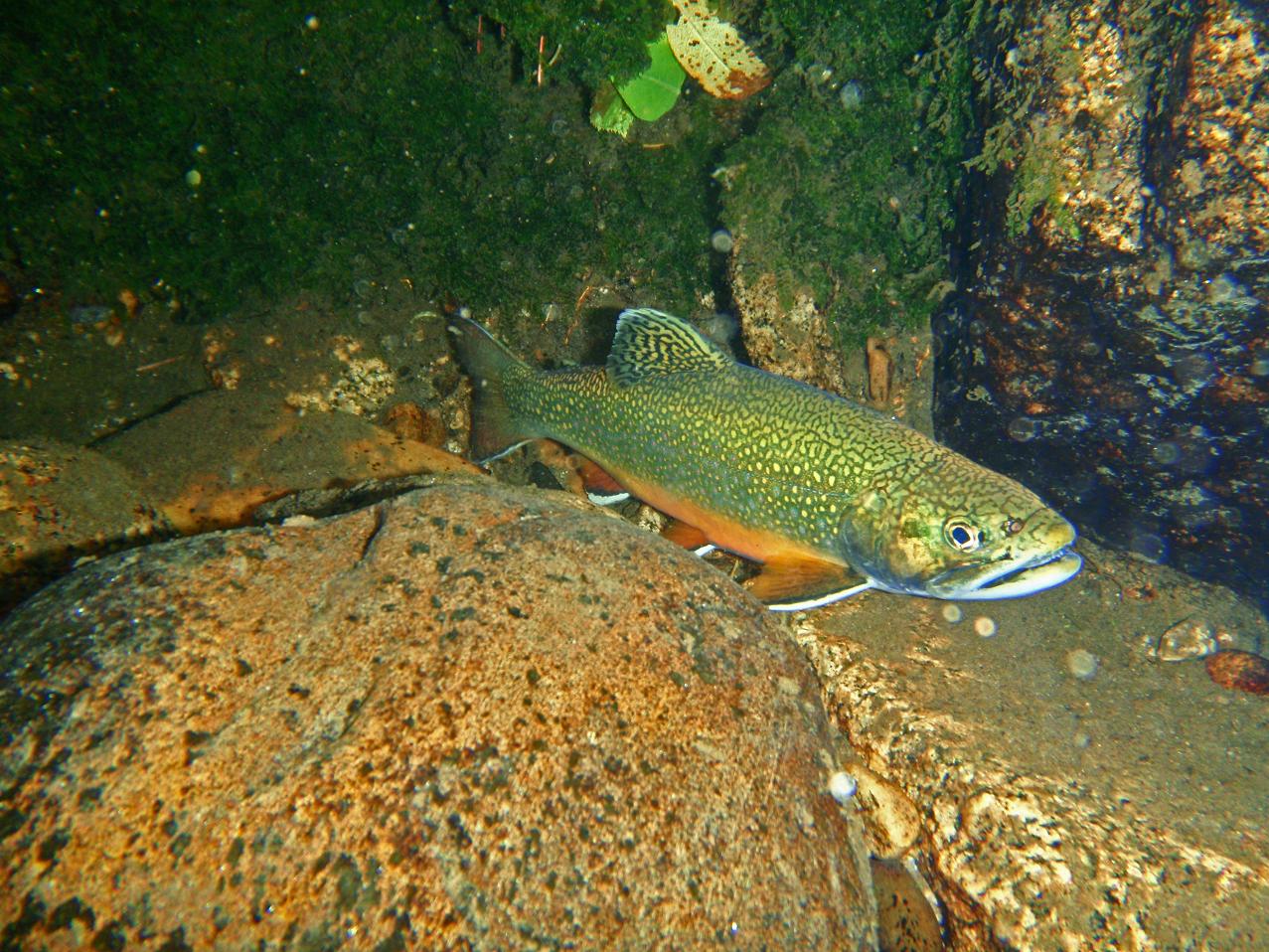
|
| Brookie smiling for the camera |
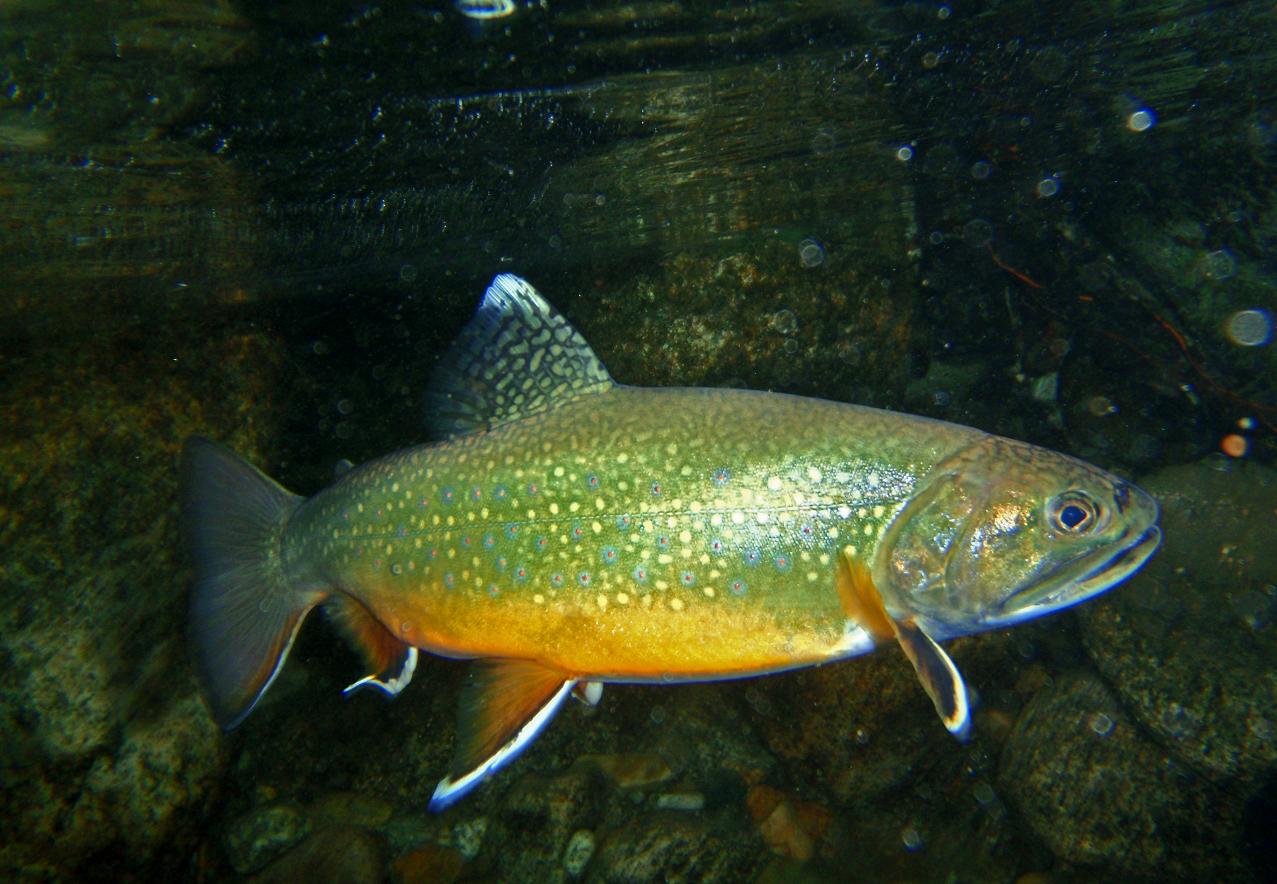
|
Wind Rivers
(September 5-14, 2008)
I just returned from a nine day backpacking and fishing trip to the Wind
River Wilderness in Wyoming. We hiked in pretty far, more than 30 miles from the car, and much of our time was spent
in areas not accessed by trails. There was lots of hiking, bush-whacking, scrambling, going over passes, route finding
through untracked country, and taking in amazing scenery. Of course, there was also a lot of fly fishing. We fished
wherever it looked like we would find trout: lakes, ponds, high mountain streams, creeks, inlets, and outlets.
Some of the fishing was a disappointment, with some very pretty waters not yielding up many trout. However, the majority
of the fishing was amazing.
| Fishing in the Wind River Range |
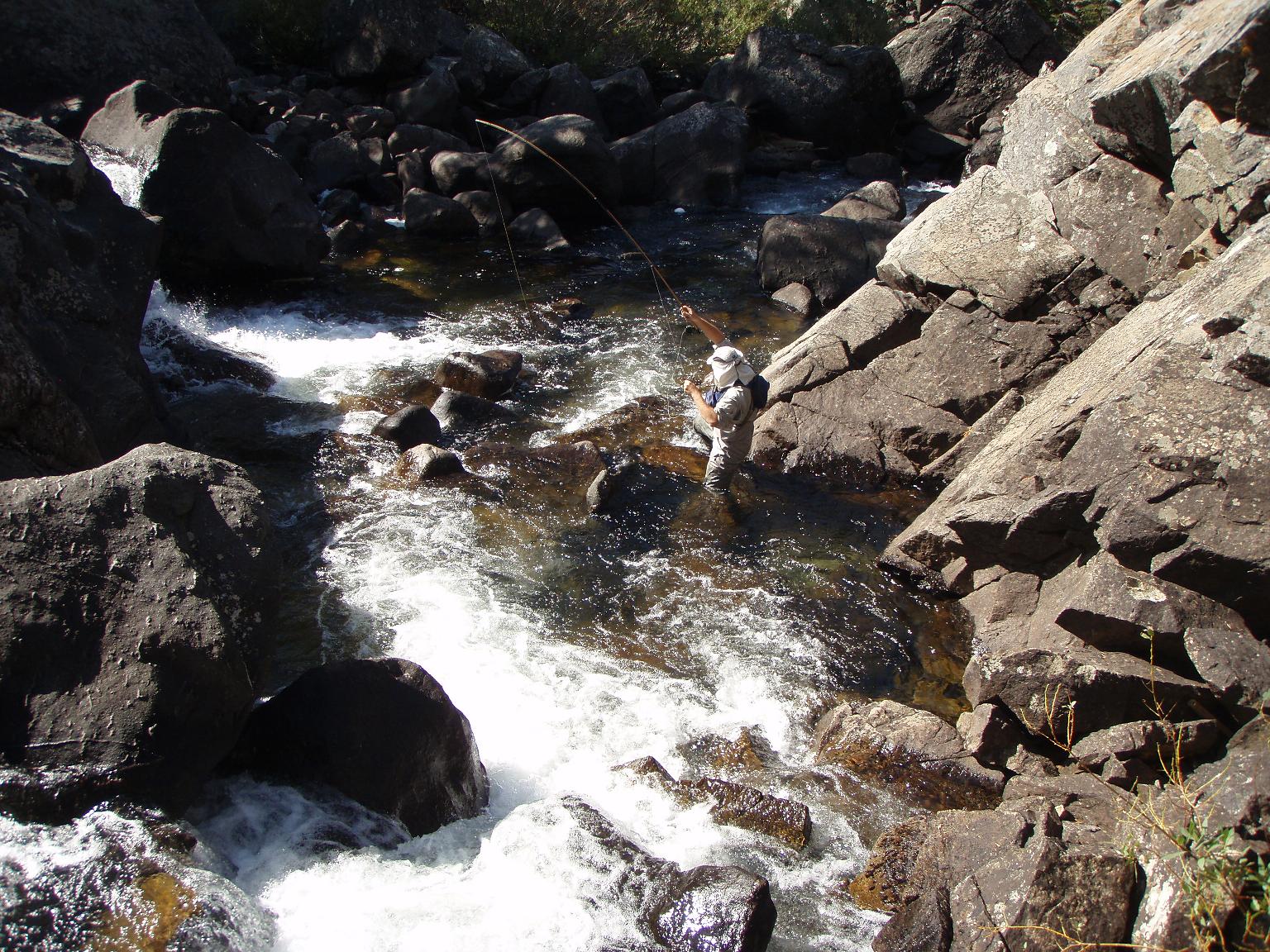
|
The trip was a wonderful adventure, and three experiences in particular
stand out in my mind as I sit and reflect on our nine days in the wilderness:
Snowflakes and dry flies:
It was late afternoon and we were setting up our camp below a mountain pass
at over 10,000 feet. A storm rolled in just as we finished putting up our tent, bringing cold and snow. We were
not far from a creek, and after our camp was secure, I bundled into my warm clothes and headed out to fish. (Scott stayed
in the snug tent, taking a nap.)
The creek was a small, shallow stream, filled with big boulders. I
hiked down about a quarter mile from our camp site and fished back up. By the time I began fishing, the initial winds
had died down, and the early evening sky was filled with snow. These were big, dime-sized snowflakes, gently falling,
slowly turning the brushy creek banks to
white.
I was fishing a dry fly with a big orange post, so I could see it on the
water. I could see the fish too. They were very active on the surface of the shallow stream, and I caught sight
of their dark backs cutting along the surface. It seemed that they were drawn to the top of the water by the falling
snowflakes, and they were definitely in an excited state.
Just about every cast produced a strike, they were hitting it hard.
Often, I could see them coming for the fly, swimming incredibly fast just barely under the surface, throwing up a wake behind
them as they cut through the water.
As the light faded, the snow fall grew heavier, and the fishing took on
a surreal quality. The big snowflakes and the grey, windless sky made the scene very like an old, jerky silent movie.
On my longer casts, I could barely pick out my fly against the grainy background, and had to judge when to set the hook by
the feel of tension in the line, listening for a sudden splash, or following the track of the fish’s V-shaped wake headed
for my faintly seen fly.
| Fishing on a Snowy Evening |

|
I kept fishing even though my guides kept icing up, and well after the low
light reduced me to slowly wading my way along the creek bottom, feeling for rocks I couldn’t really see. The
fish were not slowing down, and even in the low light, they kept hitting my fly, so I kept on casting to the faint reflection
of the water on the creek, each time telling myself, “this is the last one, no, maybe one more, just one more.”
Finally, a big trout broke off my tippet, and the challenge of tying on a new fly with my cold, red, swollen fingertips convinced
me that it was time to find my way back to camp.
I got back to our camp, and crawled into my warm sleeping bag, brewing up
some hot cider while my waders and boots froze stiff outside the tent.
The Trout Congregation.
We were far from anyplace that reasonable people would go. We’d
bushwhacked for hours through tight forest, downed trees and faint game trails. One of my pants legs was shredded by
pokey branches. I felt like I’d been wrestling with trees. We’d finally intersected the drainage we
were looking for and made camp near a beautiful, pristine creek. After erecting the tent and tossing our sleeping bags
inside, we pulled on our waders, strung up our rods, and headed for the water.
Scott was a bit quicker than I was getting ready and beat me to the first
hole, a deep flowing channel beneath a big log jam, bounded by two big boulders. He’d caught three fish by the
time I reached the water. He invited me to join him, and we pulled five or six more small trout from this hole before
things began to cool off.
The fish were all beautiful, bright creatures, with orange stripes and bellies.
I don't know what sort of trout they were. They looked a lot like greenback cut-throats, but greenbacks aren't supposed
to live in the Wind River range. They certainly fought hard, pulling strong and jumping wildly when hooked.
| Technicolor Trout |

|
We left this hole and began to work our way upstream. The water was
gorgeous. A clear creek, with lots of bends, channels, and holes to shelter fish. It was, however, uniformly empty.
After about twenty minutes of fruitless casting, wading constantly upstream, Scott and I were shaking our heads, wondering
where all the fish were.
We’d cast dries and drag nymphs and get not a single rise or strike.
Wading through pools, we’d see nothing at all. No dark fishy shapes in the water. Nothing. We worked
our way methodically through some of the best water I’ve ever seen, and encountered not a single fish.
| Empty Water |

|
We split up. I hiked ahead, and Scott continued fishing upstream,
not believing that the water wasn’t hiding fish somewhere. As I hiked alongside the stream, I heard the sound
of falling water. Before long, I came upon a beautiful, wide waterfall, cascading down broad terraces of stone into
a big, dark, swirling pool. I tossed in a fly, but the dearth of fish for the last quarter mile made me a bit pessimistic.
My fly hadn’t even had time to float a foot before a fish took it. I was too surprised to set the hook, and I
lost him. However, after that, I began fishing in earnest, and soon had caught a lot of fish.
After a while, Scott joined me, and he fished one side and I the other. We caught small fish on dry flies in the margins of the pool, and pulled out big 14
to 16 inchers on weighted nymphs that we chucked into the churning water at the base of the falls. It was a beautiful,
serene spot. Tall trees of the forest rising on two sides with the falls upstream, and the creek below.
The resonating rush of the falling water, spraying us with a fine mist. The warm afternoon sun on our faces. Scott
summed it up best. “If I die, you can just bury me here. That way, I will already be in heaven.”
| One Step Away From Heaven |

|
Between us, we probably caught a hundred fish out of that pool. Finally,
the lure of the unknown pulled us reluctantly away, and we began to explore upstream. Again, we found beautiful water.
Again, there were no fish. For a half mile or so, we worked our way up the creek, all the way to a beautiful mountain
lake. Not a single rise. Not a single fish.
We didn’t know how to explain it. So many fish in one spot,
yet the rest of the river completely barren. Scott thought that maybe the fish were spawning, and were swimming upstream
until a natural barrier like the falls impeded their progress. I had a different explanation. It was Sunday, and
we’d stumbled across a watery trout cathedral.
The Small Stream
In my daughter’s class at school they have a program they call “D.E.A.R.”
It’s an acronym that stands for “Drop Everything and Read.” At some point in the day, the school kids
stop whatever they are doing and read for a half hour. Scott and I had a similar program. We called it “Drop
Everything and Fish.” Whenever we passed a spot that looked too good to pass up, we’d drop our packs, grab
our rods, and fish for a while, until we were ready to start carrying our packs again.
It was about noon, the sun beating down on us as we passed though a high
mountain meadow with a small stream running though it. We were ready for a break, and the stream looked very inviting,
so we decided to Drop Everything and Fish. The stream was small enough that you could easily step across it in places,
and cover it in a few hops at the widest sections. Scott didn’t bother to pull on his waders, figuring that on
such a small stream, he’d just step from rock to rock.
| High Mountains, Small Stream |
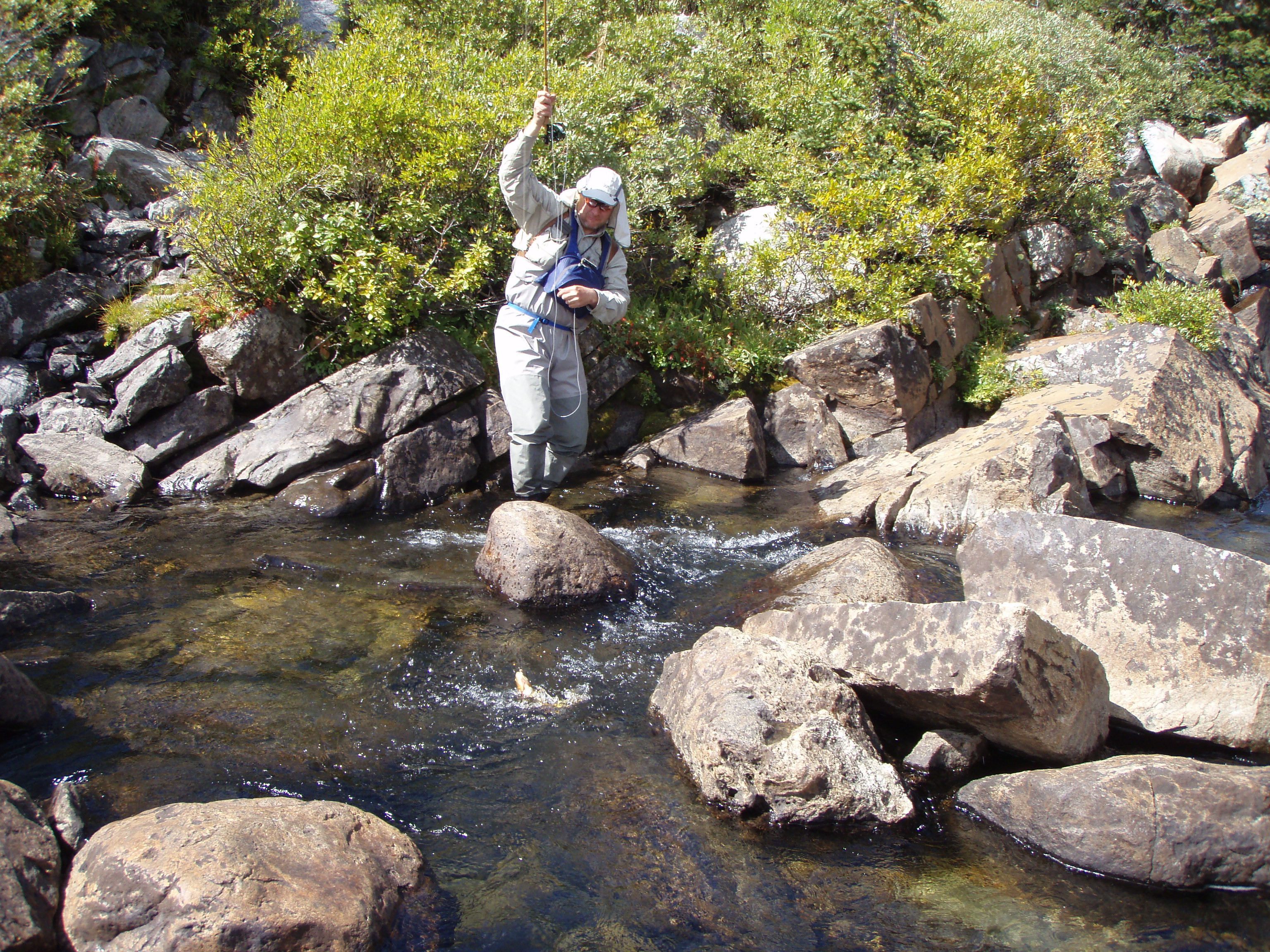
|
We began fishing, using my “ugly bug” all-purpose dry fly, which
was a fairly decent imitation of the numerous grasshoppers that were jumping and flying all around us. At this point
in the trip, we were both sharing my fly rod. Scott had broken his (graphite) rod earlier that morning, landing a fat
lake trout. I’d land a few fish, then pass my rod to Scott, and he’d catch a few, and so on.
I started fishing first, and was quickly surprised by the size of the fish
I was catching. They were big, strong fish, almost none under 10 inches long, with most of them in the 12 to 14 inch
range. On a small stream like this one, we were expecting a lot of “over the shoulder” fish, so small that
you’d fling them out of the water launching them over your shoulder when you set the hook. Not here. These
were consistent, full on six-weight rod benders.
| Small Stream Fish |
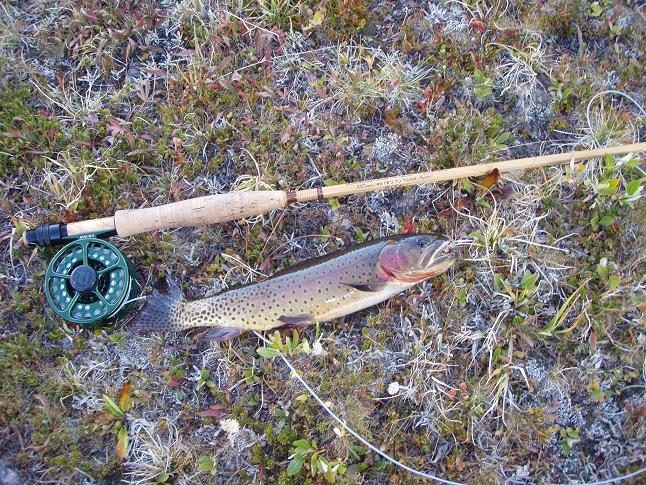
|
After a couple hundred yards of fishing, I sighted a nice sized fish, rising
in a long deep channel in the stream, where it narrowed to just a few feet wide, the banks on both sides formed of rock.
He came up and took my ugly bug off the surface and gave me a good fight.
I thought I could see another fish holding in the bottom of the channel,
however, so I handed the rod to Scott and told him to see if he could bring up the other fish. The mystery fish wouldn’t
rise to the ugly bug, so Scott tied on a big, wiggly nymph and began dragging it deep through the water.
On the third cast, the fish struck, and it was immediately apparent that
it was a big one. The rod was bending dramatically, and I began to fear for the 5x tippet.
The fish surfaced, rolling and thrashing, and we got a good view of the
biggest fish we’d seen the entire trip.
“Don’t lose him, don’t lose him, don’t lose him”
I just kept repeating this useless mantra as Scott played the delicate game of trying to control the fish without
breaking the tippet. Neither one of us had thought to bring our net on this tiny stream. We had no way of reliably
landing such a big fish. Scott wasn’t even wearing waders.
After a while, I got down into the stream, trying to help my buddy land
this heavy, angry fish, who seemed to be slowing down a bit. Almost immediately, the fish darted between my legs, then
made a u-turn back around, snaring my leg with the line. Miraculously, the tippet didn’t break, and after some
hopping, wiggling, and clumsy maneuvering, I was able to extract my leg from the leader.
I kept trying to get into a position to grab the fish, but each time I got
close, he would jet away with a renewed burst of energy, slipping through my hands.
Finally, he made a run downstream, darting between submerged boulders.
It was at this point that the line became snagged on one of the rocks, and we thought we’d lost him. “No!
No! No! No!,” I was babbling, almost frantic at the thought of breaking this one off. The line was hopelessly
snagged, and the fish was lost in the boulders. Things didn’t look good.
I peered down into the water, and caught a glimpse of a big tail waving
back and forth between two rocks. It wasn’t going anywhere, and it dawned on me that the big fish had become stuck
while trying to swim through the opening. The water was about waist deep, and I dropped down and reached for the tail,
feeling the body of the big fish, wedged into the small space between the rocks.
I didn’t care that the water was icy cold, and I didn't care that
it was rapidly filling my waders, I kept a firm grasp on the tail with my left hand, feeling my way along the fish’s
belly with my right until I reached the head and was able to jam my finger in the fish’s mouth. I worked him back,
out of the hole, and once he got loose, he began thrashing like crazy. I brought him up, clutching him tightly to my
chest, and managed to stagger over to the bank with him.
He was a beautiful fish, thick and healthy. We took a couple of pictures
and then released him back into the water, and watched him swim back into the recesses of the channel where we’d first
found him. I was completely soaked, having filled my waders down to the toes, and was quivering with the after effects
of cold water and adrenaline.
We reluctantly went back to our packs, both of us happy that we’d
taken the time to Drop Everything and Fish on this tiny mountain stream. It was one of the best surprises of our trip,
and I will remember that last fish as long as I live.
| Scott, with the Big One |
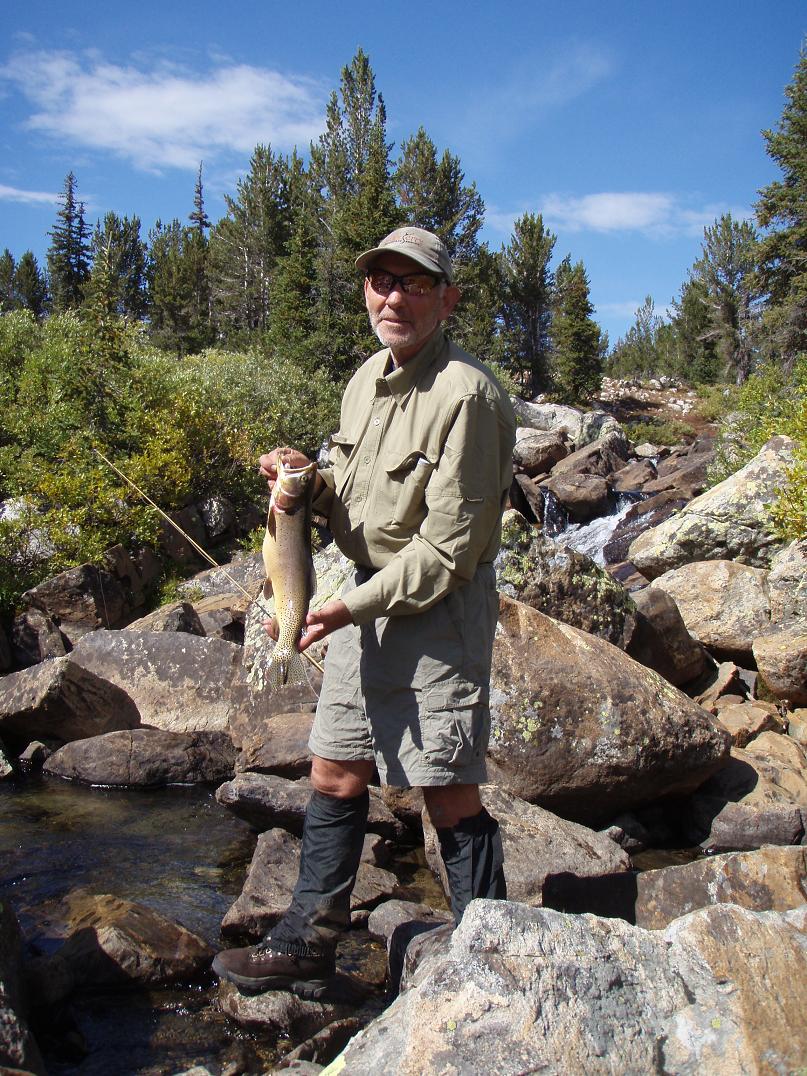
|
Greenback Cut-throat
(8/01/2008)
A buddy and I went fishing today in a creek up in Rocky Mountain National
Park that I hadn't explored before. Just about every fish we caught was a Greenback Cut-Throat. It was more than
worth the hike to be able to catch such colorful, beautiful fish.
| Greenback Cutt |

|
| Fish On |
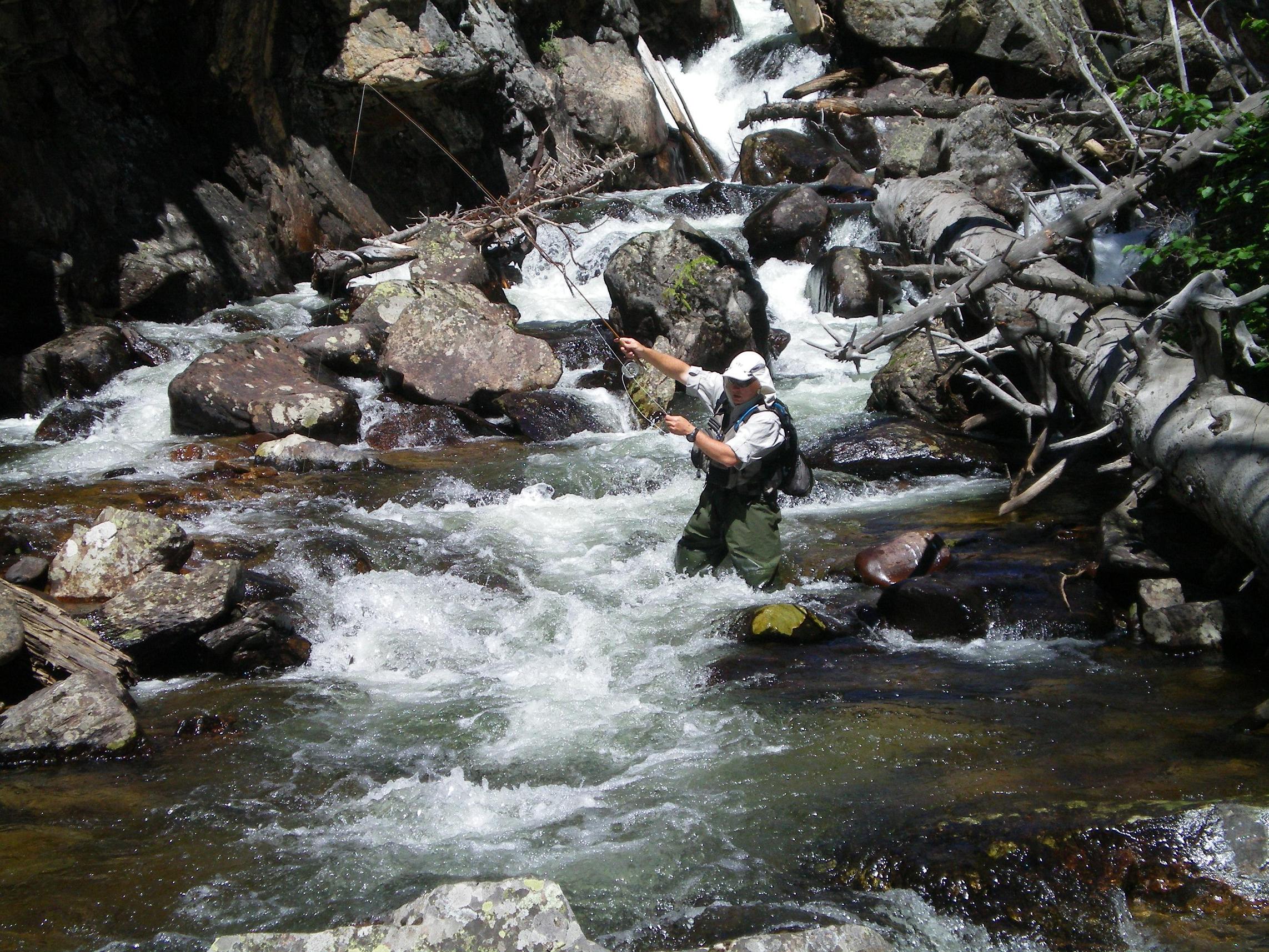
|
| Just another day in Colorado |

|
A Walk in the Park (with Brook Trout)
07/27/2008
I went fishing in Rocky Mountain National Park today. Normally, I stay away
from the Park on summer weekends. Too many tourons on a Saturday clogging up the roads, driving 5 miles per hour and blocking
traffic every half mile as they stop to gape at the elk. Even at some of the higher lakes further from the trailheads, the
chance of solitude is not that good on the weekends. However, I
was itching for some high country fishing, and because it was a Saturday, I decided to head to a small creek that I've been
meaning to explore for a while. I didn't make it out the door until after lunch time, and it was almost 3:00 by the time I
got to the pull-out at the trail head.
Only one other car parked there . . a good sign. My first view of the creek
was not all that encouraging, however. It was tiny enough to step across, and not even deep enough to cover the toes of my
boots. That's the danger of heading to waters you don't know that well. Sometimes the map can't really give you a good feel
for what you will find. I resigned myelf to the fact that I was unlikely to catch anything in such a tiny stream. I kept walking
though. It was a beautiful day, and a walk in the woods was better than staying at home watching television.
I took off at a brisk clip, following the drainage, passing the folks from
the other parked car within 500 yards. They were casual sight-see-ers wearing flip-flop sandals, and were just turning around
to head back to their car. The looked at my fishing rod, then down at the tiny trickling creek and asked me if I really thought
there would be any fish. I told them that I had never been here before, and that maybe there wouldn't be any fish. I kept
on hiking, and I didn't see another person the rest of the day until I got back to the road. I hiked for a little over an
hour.
The terrain got a lot wetter, with numerous small streams and long sections
of bog that erased the trail. I was happy for all the water, because the little creek below me kept getting steadily larger
and larger as it fed from all these tiny flows. Finally, I left
the trail and bushwhacked down to check out the creek. Even augmented by the tributaries, it was still pitifully small, no
more than ankle deep in most spots, but there were some nice undercuts, and deeper sections in the bends. Best of all, I could
see some dark fishy shapes in the water.
After following the edge of the creek for about another 20 minutes, I finally
started fishing. My rig for the day was my 4-5 weight Tom Nigro quad rod loaded with a 4 weight line. That's the rod I take
when I'm exploring a new stream and am not quite sure what to expect. It is a good all around stream rod and can handle both
long and short casting tasks.
| Brook Trout Heaven |
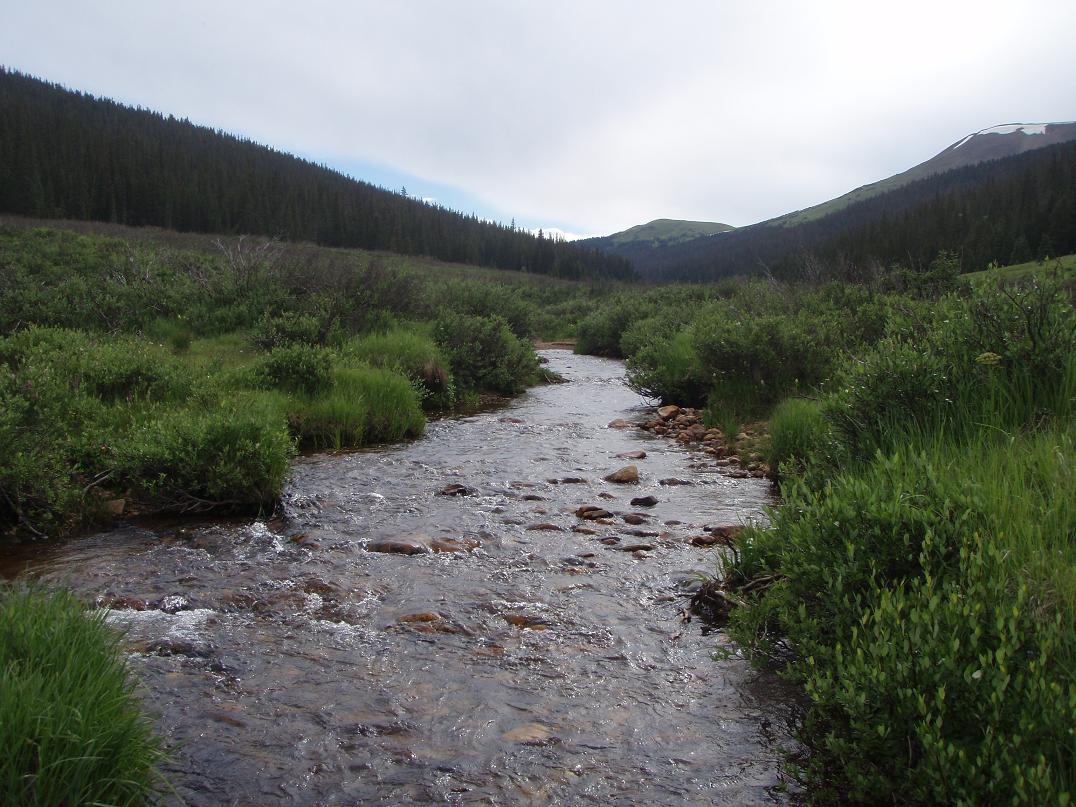
|
I tied on a generic Mayfly pattern (size 16 Wilcox's Para Variant) cast
to a small kink in the stream where it had deepened to about knee depth, and immediatly had a fish on. It was a beautiful
brookie. Dark grey back, mottled with spots, and a bright orange belly. This was an auspicious start to a day that I had not
long ago decided would likely not involve much successful fishing. I released the brookie, cast again, and within seconds
had another one on, this one shooting up out of the water on the take. I released this one, and kept on fishing, starting
into one of the most crazy-good fishing days I've had.
It's been a while since I've caught brookies. Browns, rainbows, and cut-throats
are the normal catch on the waters I fish most often. I was surprised at the fight these small fish put up. They would hit
the fly hard, often cartwheeling along the water, and then, when I'd set the hook, they would swim for the undercut banks
with a remarkable strength and speed. They were bending my rod tip, running off line like a big rainbow two or three times
their size. The browns I was catching last Thursday seemed slow and lethargic in comparison to these hyperactive brookies.
The fishing was as fast and furious as anything I've ever experienced. Just
about every cast resulted in a fish. I only fished for a couple of hours, but I am pretty sure I caught more fish in those
two hours than I've caught on my best two days previously. Very early on, I lost track of how many I caught. However, after
a while I decided to count how many fish I caught in 10 minutes. I set the timer on my watch for 10 minutes and by the time
it beeped, I'd caught and released 16 fish. If you extrapolate that out, it's almost 100 fish an hour. I could even have caught
more, except that they were taking the fly so violently that it was often stuck deep in their mouth or throat rather than
the lip, and I was having to use my forceps to get the fly loose on a lot of them.
None of these fish were big, trophy fish. They were all pretty small. However,
they had none of the skinny-malnourished "all head" look that fish sometimes get when their numbers swell. They were thick,
strong, and unbelievably feisty, punching well above their weight class when it came to giving me a fight. After a while,
that's what kept things interesting. There really wasn't any drama or suspense about whether or not I would catch a fish.
However, in the shallow water, I could see them clearly, shooting up to take the fly, and then fighting like maniacs, my rod
tip bending, and the line thrumming with their fierce energy.
It was a terrific day, even more so because I had initally been pretty disappointed
and wasn't really expecting much success. I've got a newfound respect for Brookies, and have found a great place to take my
daughter, who complains that she never catches enough fish.
| Brookie |
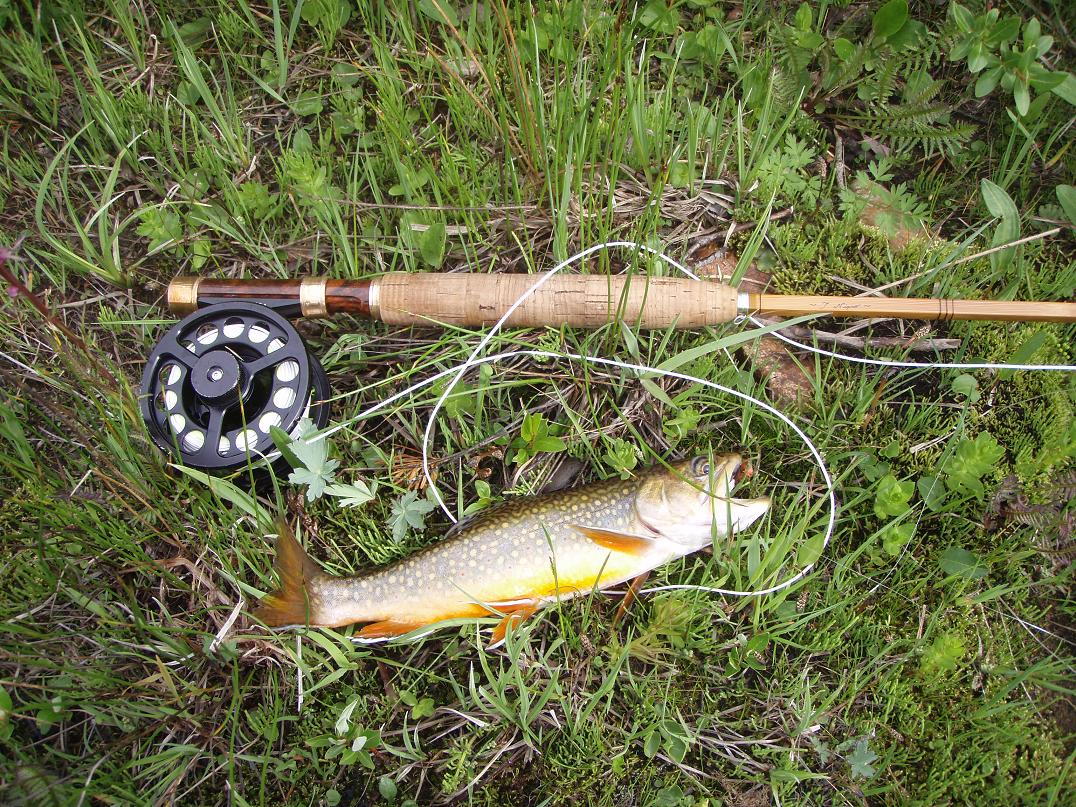
|
Indian Summer
01/08/2008
It's been cold here in Colorado, and all my favorite small streams are covered
with ice and snow.
However, a friend just sent me this picture of me fishing back in November
(with my Maurer 4 weight,) on a beautiful fall day on one of my favorite streams.
Makes me look forward to spring, and warmer temperatures.
| Indian Summer |

|
Fishing In Slow Motion
11/02/2007
I was out fishing yesterday afternoon.
Fishing
was very slow. I was fishing familiar water, but places where I normally catch fish were rather unproductive. On top of that,
I missed my first two strikes. I would see the fish rise, but seemed unable to set the hook. Finally, I got a good view of
a fish rising to my fly. He was moving very very slowly, almost in slow motion. I waited until I actually saw the fly go in
his mouth, then set the hook.
Watching the fish move so slowly, gave me a clue as to what was going on, so I used my thermometer to measure the
water temperature. Water temp was 38 degrees. No wonder the fish was so slow. I had not even thought to take that into account.
The rest of the afternoon, I changed my fishing strategy altogether. I concentrated mostly on still water. I also found that
the fish were holding in slightly different spots than they normally do. Usually, when fishing small creeks, I have the best
luck fishing on the upcurrent side of a boulder. Yesterday, the fish seemed to be holding in the downcurrent lee of the boulders.
I began picking my spots based on where a fish could hold with the absolute minimum amount of effort.
The day turned out to be one of my best days ever on this creek. The interesting
thing is that I caught bigger fish than I normally ever catch. The typical fish I catch here is a small brown trout of 6-10
inches. There are rainbows too, which tend to be a bit larger, but I usually catch 10 browns for every rainbow. Yesterday,
it was reversed. I caught 3 browns and 10 or so rainbows. I can only speculate that the rainbows were more comfortable and
less affected by the cold water temperatures.
The other interesting thing is that the fish were going after my dry fly,
even though I couldn't see any indication of insect activity at all, and the canyon was cold and shaded. I was taking beautiful
rainbows on dry flies out of deep pools where I can normally only catch rainbows on nymphs. I suppose that the fish that normally
lurk and feed on the bottom were coming to the surface looking for warmth.
The biggest challenge was slowing down my hook set. Normally, I lose fish
because I set the hook too late. Now, with the fish moving in slow motion, I had to be careful not to yank the hook away before
they had a chance to get the fly in their mouth. Learning to cast bamboo taught me to relax my casting stroke. The cold water
temperatures forced me to relax the hook set as well. It's pretty hard to pause, when you see a fish taking your fly. All
the "strike fast" conditioning has to be re-learned. Once I got it down, however, it was a lot of fun. Watching the fish slowly
move up and take your dry fly is a tantalizing and rewarding experience.
The most memorable fish of the day was taken from a long deep pool that
I've fished a number of times. It's a prime spot for trout, and I've fished it with dries and nymphs on a number of occasions.
I've always suspected that it holds bigger fish, but all I've ever managed to catch are a few smallish brown trout. I cast
my fly out in the center of the pool, and within 4 seconds had a fish on. This time, I barely saw the take at all, just a
slight ripple and a shadow below the surface as I lost sight of my fly. I tugged the rod gently, confirmed that there was
a fish on, then gave a hard tug to set the hook. It was a beautiful rainbow. He gave a good fight, but I landed him. He was
fat and healthy, and measured a full 14 inches. This may not sound like much, but for that creek, he was very good sized,
one of the biggest fish I've ever landed on those waters.
I figured that the fishing was unlikely to yield anything better than this,
so I decided to end on a high note and call it a day.
I've traditionally never fished much in the colder months, but perhaps I
will venture out a bit more even when the water temps are pretty low.
I LOVE Colorado
09/15/2007
Today, I was reminded of why I love living here in Colorado so much.
I had a busy morning, shuttling kids to various activities, but by 2:00, I was done, and had the rest of the Saturday afternoon
to do with as I wish.
I threw my fishing gear in the trunk of my car, drove up into the foothills,
hiked down to a creek, and was fishing by 3:00. It was a beautiful fall day, warm and clear. The hike to the creek was downhill,
so it was easy. I knew I'd be hiking back uphill in the evening, when it was cooler.
I got to the creek, strung up my rod and fished. I was fishing my Chris
Bogart/Shenendoah 7'6" 5 weight. I chose this rod for today because my right arm was aching and sore from a hard work-out
on Thursday, and my Bogart rod is very agressively hollowed so it's pretty light weight. In spite of the weight, it's got
enough pop to deal with wind.
The creek was running strong, and the fishing was terrific. Even though
the weather was beautiful, I fished in complete solitude. Didn't see another fisherman all afternoon. It was one of those
beautiful days when you look around you and it makes you thankful to be alive (and not living in New York City.)
| Colorado |

|
First Trip to Cheeseman Canyon
08/24/2007
Although I've lived in Colorado for more than 15 years, I'd never fished
the South Platte river until today. All the guidebooks warn about how difficult the fishing is, and it seems to be mostly
nymphing, which I don't enjoy that much, and I've always found other places to go.
But, I had the day off today, and decided that I might as well fish the
South Platte, if for no other reason than because it is a famous spot. (Kind of like visiting the Statue of Liberty if you're
in New York.)
My buddy and I got to the parking lot by 8:15, and we were fishing by 8:45.
We started out nymphing, using the teeny tiny nymphs that the local fly shop had recommended, the kind that are so small,
I could barely pick them up with my fat fingertips. We nymphed all morning long, with only a single bite between us. I tried
all sorts of combinations of weight, kept adjusting my strike indicator, and kept rotating my selection of nymphs, but the
fish weren't buying what I was selling. It was particularly frustrating, because some of the time I was sight nymphing to
big lunking trout, and they just ignored everything I drifted their way.
After lunch, we turned to dry flies. I figured that if I was going to not
catch fish, I'd rather be not catching them on a dry fly, which is more enjoyable to cast. Following the advice of guidebooks
and the wisdom of the local fly shop, I used teeny tiny dry flies: #22 parachute Adams, gnats, and assorted other micro dries.
I had no better luck with these than I did with my nymphing rig, but at least I had fun casting.
Finally, I was looking at the bleak reality that I was probably not going
to catch any fish. Six out of the seven other fishermen we had talked to had also come up empty handed, so I tried to convince
myself that I wasn't really disappointed. In desparation, I cut
off my tiny fly, and tied on my "ugly bug," a size 12 four legged dry fly monstrosity that I've been using lately with quite
a bit of success on my home waters. I began casting, and within 3 minutes, I had a hard strike. I was so excited, that I just
tried to pull in the fish without playing him, and he broke off my (8x) tippet and disappeared.
Feeling a lot better now, I began to methodically fish the left bank, putting
the fly as close to the grass and bushes as possible. About 10 minutes later, I got another hard strike. This time, it was
a big rainbow. Mindful of my thin tippet, I played him as carefully as I could, but he made it to fast, churning water. The
fight went on for a long time, and he reeled off more than half my fly line at least ten times. My buddy moved downstream
to get him in the net. I pulled the fish's head up just as he was getting netted, and the fish jerked and jumped, succeeding
in breaking off my tippet, and jumping out of the net. I was more than a little disappointed that I hadn't landed the fish (which was easily 20+ inches.) . Having lost two fish in a row, I switched
to 7x tippet.
Using my ugly bug, I continued to comb the river banks, and finally caught
(and landed) a healthy brown trout. Our day was coming to a close, but on the way out, I hooked (but didn't land) another
fish that was hiding by the bank in a dark tunnel formed by overhanging bushes.
All in all, it was a good day. Catching the single fish aleviated all of
the frustration of not catching anything for the rest of the day. I got a lot of good practice with my casting (especially
the precise placements necessitated by fishing the brushy banks.) The scenery was beautiful, and the weather was excellent.
I can see the allure of the South Platte. The fish here are definitely bigger than the trout I'm used to catching on the mountain
streams I normally fish. The memory of the fight with the big rainbow will certainly be enough to bring me back. However,
for the near future, I'll be glad to go back to my home waters, where there are fewer people, and the fish are not quite so
educated.
| Cheeseman Brown |
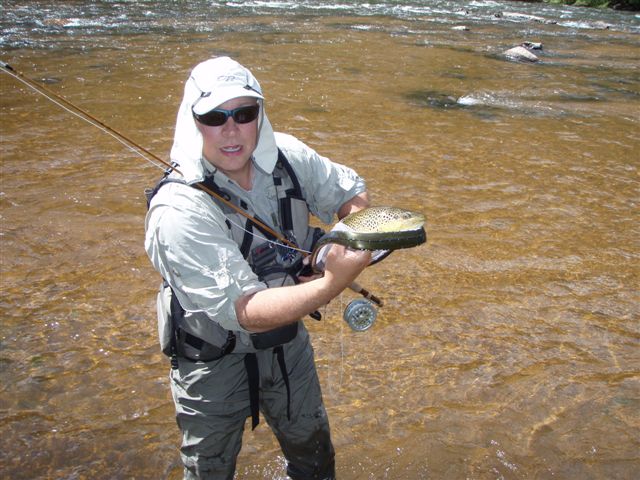
|
| Fist Fish |
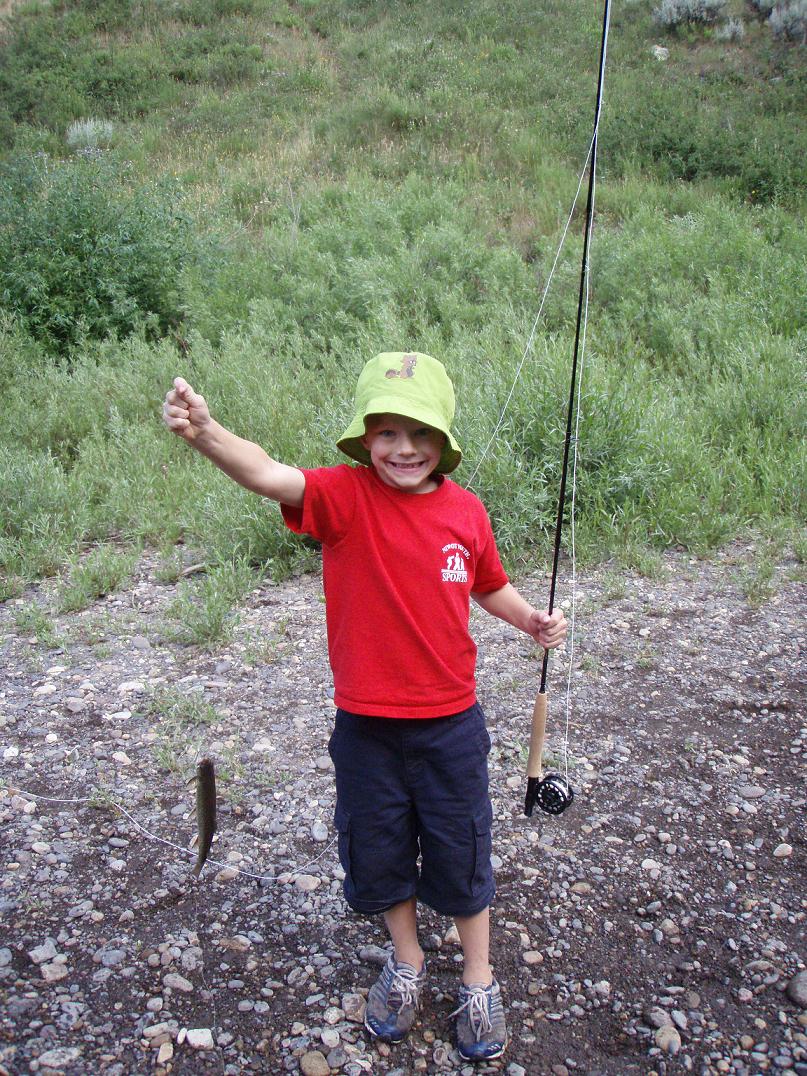
|
Family Fishing Vacation
07/20/2007
I spent the past week fishing with my entire family.
My youngest son caught his first fish on his fourth cast. It was the highlight
of the trip.
My oldest son and I fished some beautiful pocket water that led up to an
impressive waterfall.
Not a bad way to spend a week. I will choose a family vacation in the outdoors
over a trip to Disneyland every time.
| Better than an E-Ticket Ride |
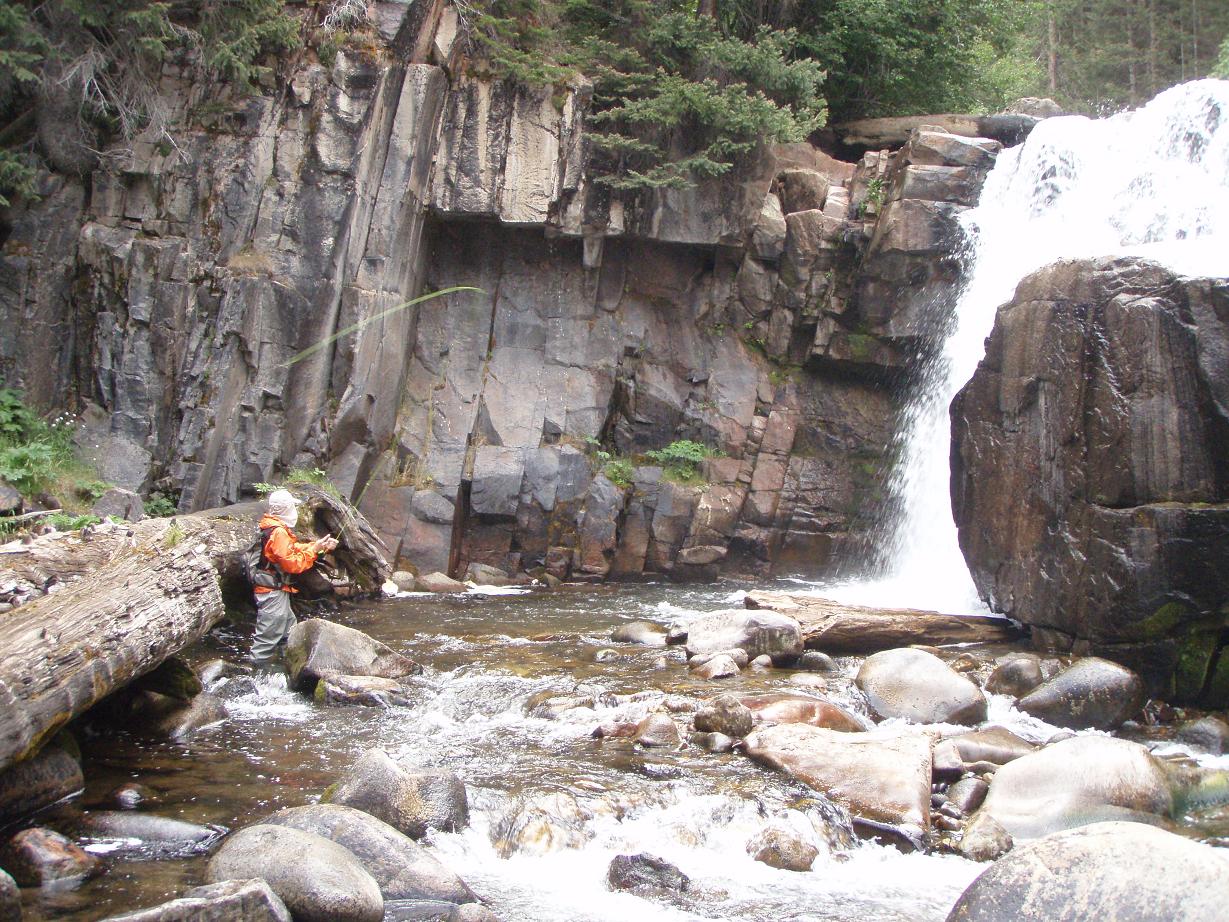
|
Pyramid Lake
1/26/2007
I had a business trip a couple of weeks ago to Reno, Nevada. I had a Tuesday
meeting in San Francisco, followed by a Thursday meeting in Reno, with nothing to do in between. I pulled out my Business
Traveler's Guide to Fly Fishing the Western States and found that Reno is close to a place called Pyramid Lake, which is world
famous for giant Lahontan Cutthroat trout.
According to the guidebook and what information I could glean on the internet,
the Lahontan Cutthroats are really big trout, with specimens of 20+ inches pretty common. I've never caught a trout that big,
so I was pretty psyched up to catch a really big trout.
I packed my 8 weight rod, big Lamson reel, and fast sinking fly line I'd
bought for steelheading (which I still haven't done yet.) I called ahead of time and mail-ordered a dozen flies from the Reno
Fly Shop so I'd be armed with the appropriate flies for my little expedition. Pyramid Lake flies are as gaudy as a casino
show-girl. They are all neon and hot pink and bright purple and sequins and glitter. They also have some really big hooks,
which I doubt that the Colorado brookies I'm used to catching could even get their mouths wide enough to swallow.
One of the things that the guidebooks and other information on Pyramid Lake
all mentioned was the tradition of fishing with step ladders. The lake has a long, wide, shallow bottom, and folks use step
ladders to allow them to cast further and reach the deeper drop-offs which is pretty far from shore. I own a step ladder,
but couldn't figure out how to get it into my carry-on luggage (or even my checked luggage,) so I figured I'd just have to
count on the power of my graphite 8 weight to get my fly out where it would do some good.
I'd never been to Reno before. In the time it took me to find my hotel (after
getting a bit lost in my rental car) I pretty much saw all of the city I think I will ever wish to see.
The morning of my trip to Pyramid Lake, I woke up early and immediately checked out the weather report. Partly sunny,
temperatures in the mid 30's, snow in the afternoon, and an Extreme High Wind Advisory. "Drivers of high profile vehicles
be advised that wind gusts over 70mph can be expected." Dang! I was hoping
that when I got to the lake that there would be less wind, but that was not the case. There was a pretty steady 30+ mph breeze
blowing, with intermittent gusts much stronger. The lake itself is set in an almost lunar landscape, with only dead tumbleweeds
and grey gravel and very little color. The water was deep blue with wind generated whitecaps.
Casting was a real chore in the high wind. With the wind at my back, I could
get the line to go forward, but the backcast was a real challenge. With a floating line, I would have just roll-cast and not
bothered with the back-cast, but with the fast sinking line, it was pretty difficult to get off a decent roll-cast. I ended
up side-arming the back cast to keep it as low as possible, and arching up the forward cast high to take the fullest possible
advantage of the wind. Even so, I managed to smack myself with the fly more than once, and embedded the hook in the back of
my head. I had a heavy pile hat on, which I was really grateful for, as it took the brunt and I only got pricked as opposed
to having to dig the big barbed hook out of my scalp.
I didn't see but two other fishermen all day. I also didn't catch anything.
The high point of the day was snagging my hook on underwater obstacles, which would temporarily give me the impression
that I might have caught a fish. I actually found myself "playing" the snags for a while, having come to the conclusion that
this was likely my only excitement.
Actually, I did have some other excitement provided by the lake itself.
One of the areas I fished involved a bit of a hike. I wanted to get to a place where few people had fished, on the hope that
this was where all the big canny cutthroats would congregate. There was a high bank with no slopes, so I had to climb down
to the water. In fact, I slid down, as the bank was composed of a layer of very slick wet clay over a harder clay surface.
Once I got out into the water, I found that I didn't have enough traction with my boots to walk back up to the shore.
Even with studded soles, I just slid. I could walk sideways, or deeper into the lake, but couldn't walk up the slope to the
shallows.
I ended up walking parallel to the shore for about a quarter mile until
the composition of the lakebed changed to a less slippery surface and I was able to get back up out of the water and onto
dry land again.
All told, I spent about 6 hours fishing.
Next time I'm in Reno on business and have an extra day to spend fishing,
I'm heading for the Truckee river.
| Pyramid Lake |
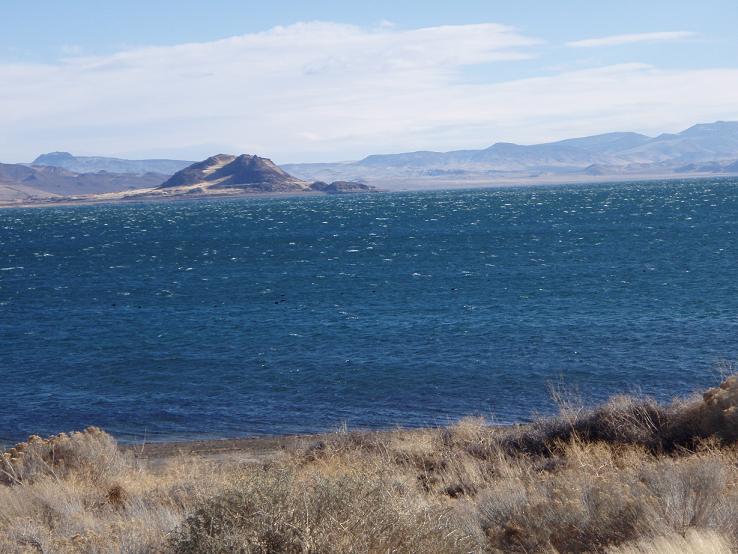
|
|

